Contents
Blackberry “Navajo” is another well-known variety of American selection, which has gained popularity not only in its homeland, but also in Europe. Blackberries of this variety are preferred by gardeners and farmers due to its high quality characteristics: unpretentiousness, stable yield, and excellent dessert taste of berries. Growing a crop in a garden plot is quite simple, since the blackberry, which is described in this article, is completely undemanding and, even with minimal care, pleases with a high yield.
Variety description
The Navajo blackberry variety is one of the most promising breeding developments of the famous University of Arkansas. It was obtained by crossing several well-known varieties with an experimental university sample Ark.550, from which it inherited many positive characteristics. Officially, the variety was patented and approved for cultivation in 1987, and for almost 30 years now it has firmly held its position as one of the best varieties for horticultural and industrial cultivation.
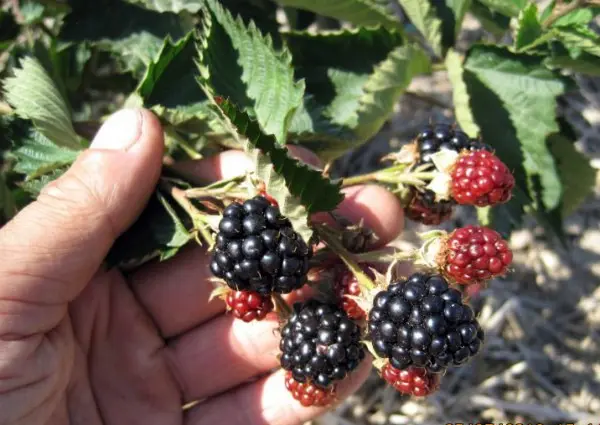
Compared to other garden hybrids, “Navajo” does not differ in large berries – the drupes of this variety reach a mass of 4–7 g, but despite this, it is considered very productive due to the record number of berries on a bush (up to 400 berries can ripen on one shoot). ). In industrial cultivation, the productivity of the variety is more than 9 tons / 1 hectare, which allows it to compete with large-fruited, but less productive varieties.
This variety of blackberries is considered late-ripening, since the berries reach full ripening in August – early September. It has many positive characteristics, including resistance to diseases and low temperatures – plants successfully overwinter at a temperature of -20 ° C. Shrubs of this variety form erect, fairly powerful shoots up to 2 m high. The stems are smooth, without thorns and thorns, they require a special approach to pruning.
Blackberries are short, conical in shape, dark blue, and when fully ripe, black. The surface of the berries is glossy, the pulp is dense and elastic. Ripe berries have a very soft, refined dessert taste without characteristic astringency and exude an amazing blackberry aroma. A distinctive feature of the berries is their excellent presentation – the drupes have the same size and shape, they are stored for a long time and well, they easily tolerate transportation.
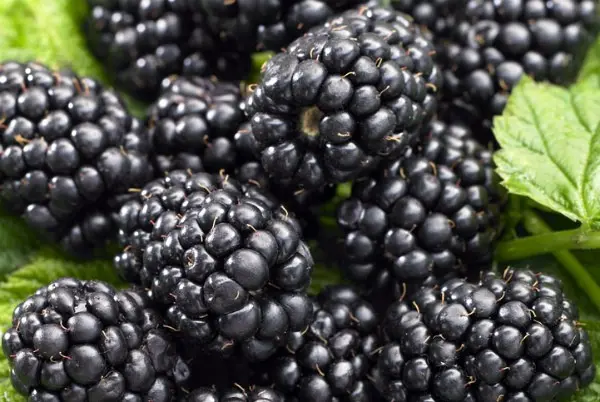
Advantages and disadvantages
Analyzing these qualities, it should be admitted that it is not so easy to find flaws in blackberries, while the advantages of the variety are obvious:
- lack of thorns – this is a big plus for blackberries, since it is the thorns that complicate the process of harvesting and caring for plants;
- relatively high frost resistance – most hybrid blackberry varieties are not able to survive temperatures of -15 ° C, and the Navajo variety can remain without shelter in a cold winter (up to -20 ° C);
- high immunity to diseases – the blackberry of this variety practically does not get sick, it does not require additional processing from pests and diseases, which greatly facilitates the care of the crop;
- high yield – with a relatively small size of berries, the variety is highly productive due to abundant fruiting;
- ease of care – blackberries with erect stems are easier to care for, prune;
- unpretentiousness to growing conditions – of course, the berries will be larger and sweeter if the bush is planted in a sunny place, but the shade for this variety is also not a problem;
- good preservation and transportability of berries – despite the fact that blackberries of this variety are quite juicy, the berries remain elastic for a long time and do not flow;
- long fruiting (3-4 weeks);
- ease of harvesting – the berries are arranged in brushes consisting of dozens of drupes, so picking berries is a real pleasure;
- the excellent dessert taste of berries is, perhaps, the main argument in favor of the Navajo variety.
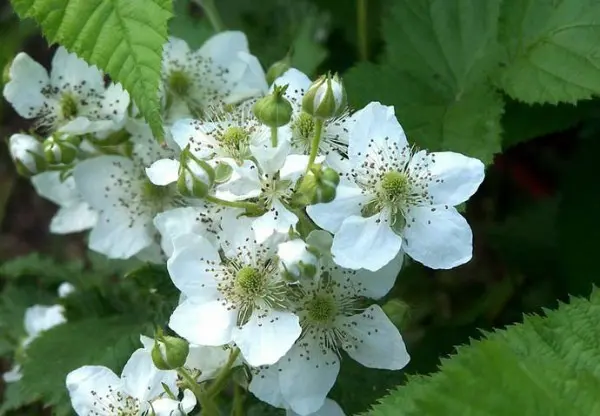
According to gardeners, “Navajo” is the most “problem-free” variety among all garden hybrids of domestic and foreign selection. It is ideal for you if there is no way to spend a lot of time caring for the berry.
Peculiarities of growing
As already noted, the blackberry of this variety grows better and bears fruit in areas where there is a lot of heat and light. Partial shade is not an obstacle to fruiting and high yields, however, berries that have received less solar heat will grow less sweet and fragrant.
As an unpretentious plant, blackberries can grow on any soil, but to get a good harvest, it is better to plant the crop in light sandy or loamy soil enriched with humus and having neutral or slightly increased acidity. Too moist soil in a lowland or with a high level of groundwater is not suitable for blackberries – its root system rots from waterlogging.
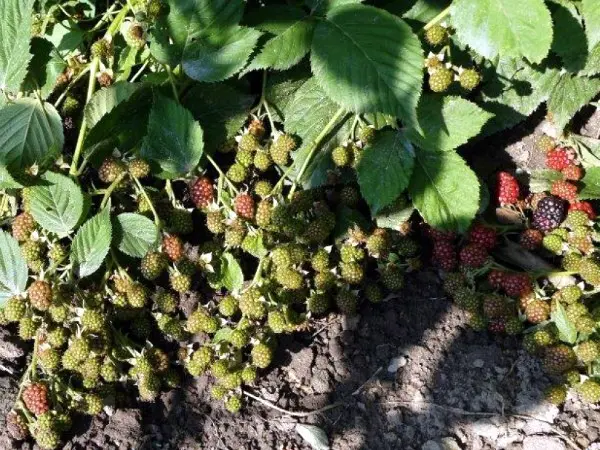
With proper care, the Navajo blackberry bush can bear fruit for 10-15 years, so the planting process should be approached as if you were planting a perennial fruit tree. The landing pit should have the appropriate dimensions: a diameter of 60 cm and a depth of at least 50 cm. A bucket of humus, a couple of glasses of ash, 80–100 g of mineral fertilizers should be poured into the pit.
The most suitable time for planting blackberries is spring, but in the climate of the central strip, a crop can be planted in early summer. The earlier the bush is planted, the more time it has to take root before the onset of constant cold weather. Autumn planting of seedlings is not practiced, since the culture has a low winter hardiness.
Since the Navajo variety has erect stems, planting in rows near the fence is acceptable for it. If the seedlings are planted in holes, then the distance between the bushes should be 1,5–2 m. The bushes of this blackberry do not belong to tall plants, so you can do without installing trellises, but in this case, pruning of the main shoots at the level of side branches is required.
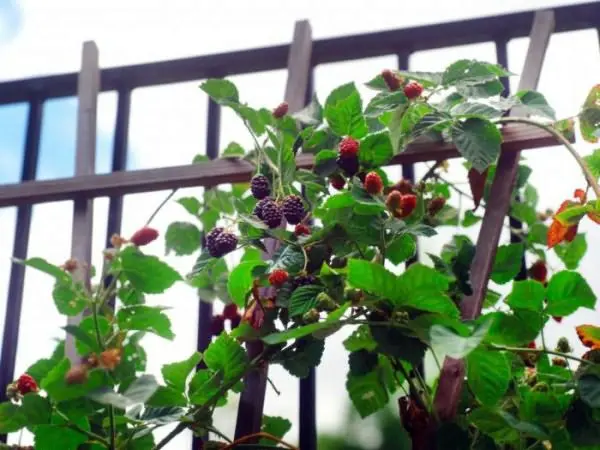
Thinness of care
Basic care for Navajo blackberries is no different from caring for other garden hybrids. On the contrary, given that this variety is characterized by erect stems, we can say that it is simpler, although it has its own subtleties:
- it is recommended to pinch (cut) young shoots not only in autumn, but also at the beginning of summer, when their height exceeds 1 m, while shortening the top by 20-25 cm, as well as lateral shoots – the procedure stimulates the growth of lateral branches, increases flowering and ovary formation ;
- it is more convenient to use T-shaped trellises for tying plants, however, if the shoots are correctly cut and normalized, you can do without support;
- bush rationing is carried out in autumn according to the standard scheme, which assumes 7–8 productive shoots per bush in the remainder;
- preparation for winter includes the removal of old and underdeveloped young shoots under the root, the removal of branches from the trellis, the shelter of the bush with organic mulch, as well as insulating material.

Standard care measures include periodic watering 1–2 times / 1 week, fertilizing, loosening the soil between rows and tree trunks. While the seedling is small, it is necessary to loosen the soil more often and remove weeds. When the bush grows, loosening around it is undesirable, since if the integrity of the root system is violated, processes often appear that grow and lead to thickening of the bush.

Blackberries are undemanding to top dressing. As a rule, autumn mulching is enough for her, however, for better growth and vegetation in spring, 20–25 g of nitrogen fertilizer (urea, ammonium nitrate) can be applied under a bush, and 30 g of potassium during the ripening period of berries. Once every 3–4 years, the bushes are fed in the spring with compost or humus in the amount of 4–6 buckets / 1 adult bush.
Experienced gardeners who have dealt with the cultivation of Navajo blackberries claim that the cultivation of the crop is much easier than with other garden varieties. Bushes practically do not get sick, are not damaged by pests, bloom profusely in early summer and are literally strewn with berries at the end of the season – in August.
Video “Rooting blackberries”
This video shows in detail how to make blackberry seedlings with a great root system.









